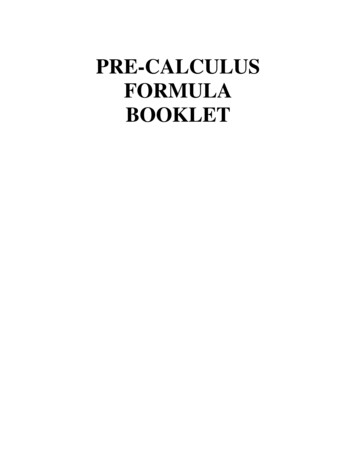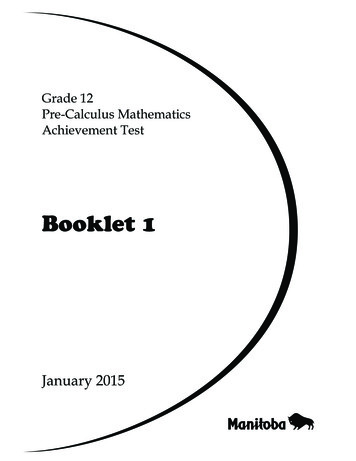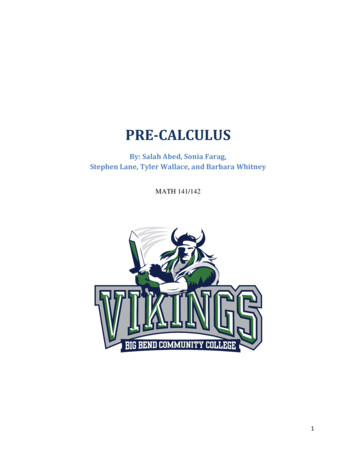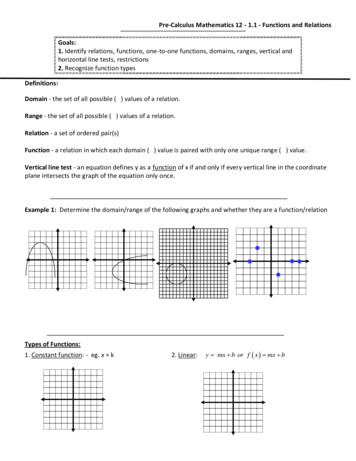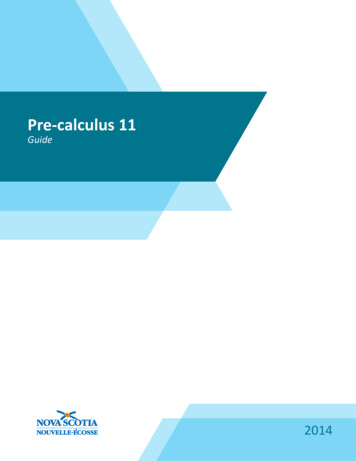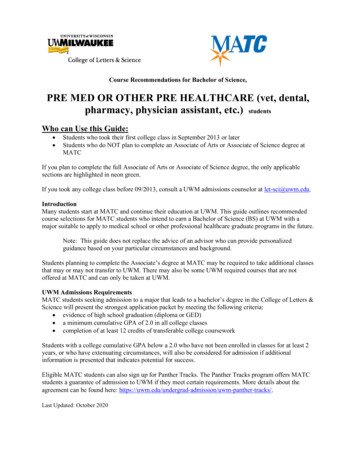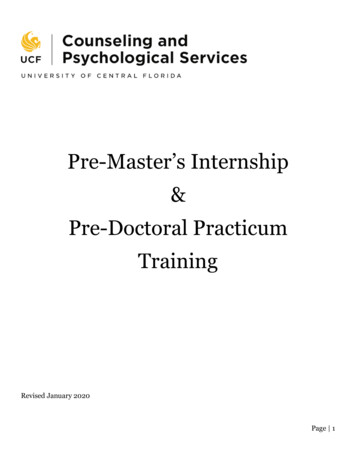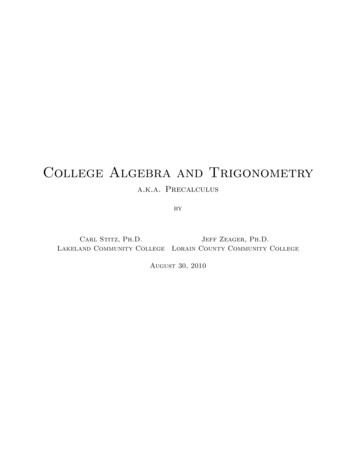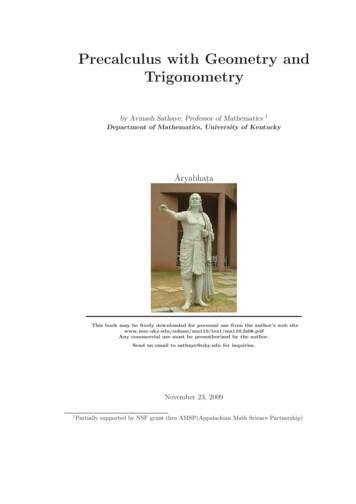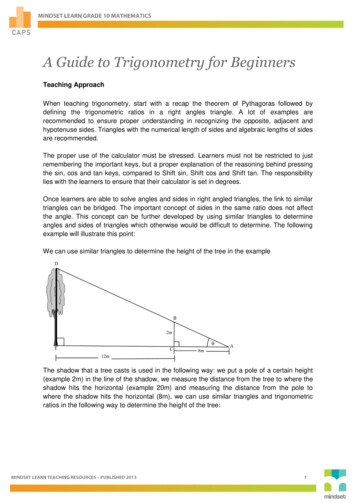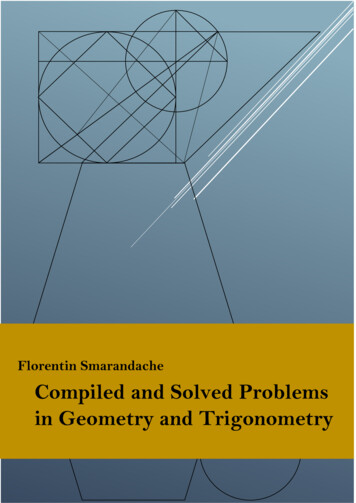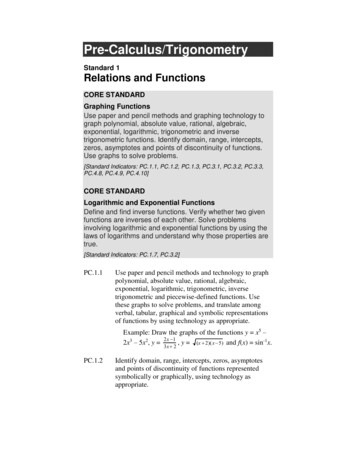
Transcription
Pre-Calculus/TrigonometryStandard 1Relations and FunctionsCORE STANDARDGraphing FunctionsUse paper and pencil methods and graphing technology tograph polynomial, absolute value, rational, algebraic,exponential, logarithmic, trigonometric and inversetrigonometric functions. Identify domain, range, intercepts,zeros, asymptotes and points of discontinuity of functions.Use graphs to solve problems.[Standard Indicators: PC.1.1, PC.1.2, PC.1.3, PC.3.1, PC.3.2, PC.3.3,PC.4.8, PC.4.9, PC.4.10]CORE STANDARDLogarithmic and Exponential FunctionsDefine and find inverse functions. Verify whether two givenfunctions are inverses of each other. Solve problemsinvolving logarithmic and exponential functions by using thelaws of logarithms and understand why those properties aretrue.[Standard Indicators: PC.1.7, PC.3.2]PC.1.1Use paper and pencil methods and technology to graphpolynomial, absolute value, rational, algebraic,exponential, logarithmic, trigonometric, inversetrigonometric and piecewise-defined functions. Usethese graphs to solve problems, and translate amongverbal, tabular, graphical and symbolic representationsof functions by using technology as appropriate.Example: Draw the graphs of the functions y x5 –2x 12x3 – 5x2, y 3x 2 , y (x 2)(x 5) and f(x) sin-1x.PC.1.2Identify domain, range, intercepts, zeros, asymptotesand points of discontinuity of functions representedsymbolically or graphically, using technology asappropriate.
Example: Let R(x) 1x 2. Find the domain of R(x)(i.e., the values of x for which R(x) is defined). Also,find the range and asymptotes of R(x).PC.1.3Solve word problems that can be modeled usingfunctions and equations.Example: You are on the committee for planning theprom and need to decide what to charge for tickets.Last year you charged 5.00 and 400 people boughttickets. Earlier experiences suggest that for every 20cent decrease in price you will sell 20 extra tickets.Use a spreadsheet and write a function to show howthe amount of money in ticket sales depends on thenumber of 20-cent decreases in price. Construct agraph that shows the price and gross receipts. Whatticket price maximizes revenue?PC.1.4Recognize and describe continuity, end behavior,asymptotes, symmetry and limits and connect theseconcepts to graphs of functions.Example: Determine the numbers a and b so that thefollowing function is continuous: x2 if x 1f(x) ax b if 1 x 25 – x if x 2PC.1.5Find, interpret and graph the sum, difference, productand quotient (when it exists) of two functions andindicate the relevant domain and range of the resultingfunction.Example: Find (f g)(x) if f ( x) g ( x) PC.1.61andx 2x. State the domain of (f g )(x).x 1Find the composition of two functions and determinethe domain and the range of the composite function.Conversely, when given a function, find two otherfunctions for which the composition is the given one.Example: If h( x) (2 x 3)4 , find functions f and gso that f g h .
PC.1.7Define and find inverse functions, their domains andtheir ranges. Verify symbolically and graphicallywhether two given functions are inverses of each other.Example: Find the inverse function of h(x) (x – 2)3.PC.1.8Apply transformations to functions and interpret theresults of these transformations verbally, graphicallyand numerically.Example: Explain how you can obtain the graph ofg(x) - 2(x 3)2 – 2 from the graph of f(x) x2.Standard 2ConicsCORE STANDARDConic SectionsDerive equations for conic sections. Graph conic sections byhand by completing the square and find foci, centers,asymptotes, eccentricity, axes and vertices as appropriate.[Standard Indicators: PC.2.1, PC.2.2]PC.2.1Derive equations for conic sections and use theequations that have been found.Example: Derive an equation for the ellipse with fociat (-1, 0) and (1, 0) that contains the point (0, 2).PC.2.2Graph conic sections with axes of symmetry parallel tothe coordinate axes by hand, by completing the square,and find the foci, center, asymptotes, eccentricity, axesand vertices (as appropriate).( x 2) 2 ( y 3) 2 1 . Find its49foci, centers, asymptotes, eccentricity, axes andvertices (as appropriate).Example: GraphStandard 3Logarithmic and ExponentialFunctionsCORE STANDARDGraphing FunctionsUse paper and pencil methods and graphing technology to
graph polynomial, absolute value, rational, algebraic,exponential, logarithmic, trigonometric and inversetrigonometric functions. Identify domain, range, intercepts,zeros, asymptotes and points of discontinuity of functions.Use graphs to solve problems.[Standard Indicators: PC.1.1, PC.1.2, PC.1.3, PC.3.1, PC.3.2, PC.3.3,PC.4.8, PC.4.9, PC.4.10]CORE STANDARDLogarithmic and Exponential FunctionsDefine and find inverse functions. Verify whether two givenfunctions are inverses of each other. Solve problemsinvolving logarithmic and exponential functions by using thelaws of logarithms and understand why those properties aretrue.[Standard Indicators: PC.1.7, PC.3.2]PC.3.1Compare and contrast symbolically and graphicallyy e x with other exponential functions.Example: Graph y e x , y 3x and y 2-x . Showhow to rewrite 3x and 2-x as ekx for certain values ofk.PC.3.2Define the logarithmic function g(x) loga x as theinverse of the exponential function f(x) ax. Apply theinverse relationship between exponential andlogarithmic functions and apply the laws of logarithmsto solve problems.Example: Simplify the expression eln 8 .PC.3.3Analyze, describe and sketch graphs of logarithmic andexponential functions by examining intercepts, zeros,domain and range, and asymptotic and end behavior.Example: For the function l ( x) log10 ( x 4) , findits domain, range, x-intercept and asymptote, andsketch the graph.PC.3.4Solve problems that can be modeled using logarithmicand exponential functions. Interpret the solutions anddetermine whether the solutions are reasonable.Example: The amount A of a radioactive element (ingm) after t years is given by the formula: A(t)
100e-0.02t. Find t when the amount is 50 gm, 25 gmand 12.5 gm. What do you notice about these timeperiods?Standard 4TrigonometryCORE STANDARDUnit CircleDefine sine and cosine using the unit circle. Convertbetween degree and radian measures. Use the values of theππππsine, cosine and tangent functions at 0, 6, 4, 3 and 2radians and their multiples.[Standard Indicators: PC.4.4, PC.4.5, PC.4.6]CORE STANDARDTrigonometric FunctionsDefine and analyze trigonometric functions, including inversefunctions. Solve problems involving trigonometric functionsand prove trigonometric identities.[Standard Indicators: PC.4.8, PC.4.9, PC.4.10, PC.4.11]CORE STANDARDGraphing FunctionsUse paper and pencil methods and graphing technology tograph polynomial, absolute value, rational, algebraic,exponential, logarithmic, trigonometric and inversetrigonometric functions. Identify domain, range, intercepts,zeros, asymptotes and points of discontinuity of functions.Use graphs to solve problems.[Standard Indicators: PC.1.1, PC.1.2, PC.1.3, PC.3.1, PC.3.2, PC.3.3,PC.4.8, PC.4.9, PC.4.10]PC.4.1Define and use the trigonometric ratios cotangent,secant and cosecant in terms of angles of right triangles.Example: Use the relationships among the lengths ofthe sides of a 30 - 60 right triangle to find the exactvalue of the secant of 30 .PC.4.2Model and solve problems involving triangles usingtrigonometric ratios.
Example: Find the area of ABC if a, which is theside opposite angle A, measures 5 units; b, which isthe side opposite angle B, measures 8 units; andangle C , which is the angle opposite c, measures30 .PC.4.3Develop and use the laws of sines and cosines to solveproblems.Example: You want to determine the location of awater tower by taking measurements from twopositions three miles apart. From the first position,the angle between the water tower and the secondposition is 78º. From the second position, the anglebetween the water tower and the first position is 53º.How far is the water tower from each position?PC.4.4Define sine and cosine using the unit circle.Example: Find the acute angle A for which sin 150º sin A.PC.4.5Develop and use radian measures of angles, measureangles in degrees and radians, and convert betweendegree and radian measures.Examples: PC.4.6Convert 90º, 45º and 30º to radians.Find the length of an arc subtended by an angle5 ofradians on a circle of radius 5 cm.6Deduce geometrically and use the value of the sine, cosine and tangent functions at 0, , , and6 4 32radians and their multiples.Example: Find the values of cos2 PC.4.73,sin-1- 32 2,tan3 4,cscand sin 3π.Make connections among right triangle ratios,trigonometric functions and the coordinate function onthe unit circle.Example: Angle A is a 60º angle of a right trianglewith a hypotenuse of length 14 and a shortest side oflength 7. Find the exact sine, cosine, and tangent of
angle A. Find the real numbers x, 0 x 2π, withexactly the same sine, cosine and tangent values.PC.4.8Analyze and graph trigonometric functions, includingthe translation of these trigonometric functions.Describe their characteristics (i.e., spread, amplitude,zeros, symmetry, phase, shift, vertical shift, frequency).Example: Draw the graph of y 5 sin (x –PC.4.9 3 ).Define, analyze and graph inverse trigonometricfunctions and find the values of inverse trigonometricfunctions.Example: Graph f(x) sin-1x.PC.4.10Solve problems that can be modeled usingtrigonometric functions, interpret the solutions anddetermine whether the solutions are reasonable.Example: In Indiana, the length of a day in hoursvaries through the year, usually with the longest dayof about 14 hours on June 21 and the shortest day ofabout 10 hours on December 21. Model this situationwith a sine function, by giving both the graph of thisfunction and its formula. Find another day that is aslong as July 4 by using your model.PC.4.11 Derive the fundamental Pythagorean trigonometricidentities; sum and difference identities; half-angle anddouble-angle identities; and the secant, cosecant andcotangent functions. Use these identities to verify otheridentities and simplify trigonometric expressions.Example: Find the acute angle between the linesgiven by y 2x and y 3x.PC.4.12Solve trigonometric equations and interpret solutionsgraphically.Example: Solve 3 sin 2x 1 for x between 0 and 2π.Standard 5Polar Coordinates and ComplexNumbersCORE STANDARDPolar Coordinates and Complex Numbers
Define and use polar coordinates and complex numbers.Graph equations in the polar coordinate plane. Use theirrelation to trigonometric functions to solve problems.[Standard Indicators: PC.5.1, PC.5.2, PC.5.3, PC.5.4]PC.5.1Define and use polar coordinates and relate polarcoordinates to Cartesian coordinates.Example: Convert the polar coordinate (2,Cartesian coordinates.PC.5.2 3)toRepresent equations given in Cartesian coordinates interms of polar coordinates.Example: Represent the equation x2 y2 4 in termsof polar coordinates.PC.5.3Graph equations in the polar coordinate plane.Example: Graph y 1 – cos .PC.5.4Define complex numbers, convert complex numbers topolar form and multiply complex numbers in polarform.Example: Write 3 3i and 2 – 4i in trigonometricform and then multiply the results.PC.5.5Prove and use De Moivre’s Theorem.Example: Simplify (1 – i)23. Standard 6Sequences and SeriesCORE STANDARDSequences and SeriesDefine arithmetic and geometric sequences and series.Prove and use the sum formulas for arithmetic series and forfinite and infinite geometric series. Describe the concept ofthe limit of a sequence and a limit of a function. Decidewhether simple sequences converge or diverge andrecognize an infinite series as the limit of a sequence ofpartial sums. Use series to solve problems. Derive thebinomial theorem by combinatorics.[Standard Indicators: PC.6.1, PC.6.2, PC.6.3]PC.6.1Define arithmetic and geometric sequences and series.
Example: Write an example and explain thedifferences among each of the following sequencesand series: arithmetic sequence, geometric sequence,arithmetic series and geometric series.PC.6.2Derive and use formulas for finding the general termfor arithmetic and geometric sequences.Example: Write the general term formula for thearithmetic sequence with initial term two andcommon difference three.PC.6.3Develop, prove and use sum formulas for arithmeticseries and for finite and infinite geometric series.Example: Find the sum of the infinite geometricseries 8 4 2 .PC.6.4Generate a sequence by using recursion.Example: Write the first five terms of the Fibonaccisequence with a1 1, a2 1, and an an-1 an-2 for n 3. Observe a pattern of even and odd terms for thissequence. Prove that your observation is correct.PC.6.5Describe the concept of the limit of a sequence and alimit of a function. Decide whether simple sequencesconverge or diverge. Recognize an infinite series as thelimit of a sequence of partial sums.Example: Find the limit as n of the sequence2n 13n 2PC.6.6and the limit as x 5 of the functionx 2 52.x 5Model and solve word problems involving applicationsof sequences and series, interpret the solutions anddetermine whether the solutions are reasonable.Example: You put one grain of rice on the square ofa chess board the first day, two on a second squarethe next day and continue to double the number ofgrains of rice you place each day through the 64thday. How many grains of rice need to be used on the64th square on the 64th day? How many grains of ricewere used all together?PC.6.7Derive the binomial theorem by combinatorics.Example: Give an algebraic and combinatorial proofof the binomial theorem if a and b are real numbersand n is a positive integer.
Standard 7Vectors and Parametric EquationsPC.7.1Define vectors as objects having magnitude anddirection. Represent vectors geometrically.Example: Graph the vector that goes from point p (3, 2) to the point q (5, 6).PC.7.2Use parametric equations to represent situationsinvolving motion in the plane.Example: Car A is traveling east at 40 mph, and CarB is traveling north at 30 mph. Both are headingtoward the same intersection. Car A is five milesfrom the intersection when car B is four miles fromthe intersection. Write the parametric equations thatdescribe the position of each car as a function oftime.PC.7.3Convert between a pair of parametric equations and anequation in x and yExample: Given the parametric equations x 3t 2and y t 1 , find an equation relating x and y.PC.7.4Analyze planar curves, including those given inparametric form.Example: Describe the curve that is defined by theparametric equations x 5 cos t and y 5 sin t for0 t PC.7.5Model and solve problems using parametric equations.Example: For the problem in Standard 7.2, write aformula for the distance between the cars as afunction of time and then find when the cars are theclosest.Standard 8Data AnalysisPC.8.1Find linear models by using median fit and leastsquares regression methods. Decide which amongseveral linear models gives a better fit. Interpret theslope in terms of the original context.
Example: Measure the wrist and neck size of eachperson in your class and make a scatter plot. Find themedian fit line and the least squares regression line.Which line is a better fit? Explain your reasoning.PC.8.2Calculate and interpret the correlation coefficient. Usethe correlation coefficient and residuals to evaluate a“best-fit” line.Example: Calculate and interpret the correlationcoefficient for the linear regression model in the lastexample. Graph the residuals and evaluate the fit ofthe linear equation.PROCESS STANDARDSIndiana’s Academic Standards for Mathematics describe the keycontent of each grade level and course, and students mustdevelop conceptual understanding of this content. The AmericanDiploma Project noted that, “beyond acquiring proceduralmathematical skills with their clear methods and boundaries,students need to master the more subjective skills of reading,interpreting, representing and ‘mathematicizing’ a problem” (p.55).The National Council of Teachers of Mathematics has describedfive Process Standards that “highlight ways of acquiring and usingcontent knowledge” (p. 29). The following Process Standardsmust be addressed throughout the learning and teaching ofIndiana’s Academic Standards for Mathematics in all grade levelsin mathematics.Problem Solving Build new mathematical knowledge through problemsolving.Solve problems that arise in mathematics and in othercontexts.Apply and adapt a variety of appropriate strategies tosolve problems.Monitor and reflect on the process of mathematicalproblem solving.Reasoning and Proof Recognize reasoning and proof as fundamental aspectsof mathematics.Make and investigate mathematical conjectures.Develop and evaluate mathematical arguments andproofs.Select and use various types of reasoning and methods
of proof.Communication Organize and consolidate mathematical thinking throughcommunication.Communicate mathematical thinking coherently andclearly to peers, teachers and others.Analyze and evaluate the mathematical thinking andstrategies of others.Use the language of mathematics to expressmathematical ideas precisely.Connections Recognize and use connections among mathematicalideas.Understand how mathematical ideas interconnect andbuild on one another to produce a coherent whole.Recognize and apply mathematics in contexts outside ofmathematics.Representation Create and use representations to organize, record andcommunicate mathematical ideas.Select, apply and translate among mathematicalrepresentations to solve problems.Use representations to model and interpret physical,social and mathematical phenomena.In addition, estimation, mental computation and technology areareas that need to be addressed at all grade levels inmathematics.Estimation and Mental Computation Know and apply appropriate methods for estimating theresults of computations.Use estimation to decide whether answers arereasonable.Decide when estimation is an appropriate strategy forsolving a problem.Determine appropriate accuracy and precision ofmeasurement in problem situations.Use properties of numbers and operations to performmental computation.Recognize when the numbers involved in a computationallow for a mental computation strategy.Technology Technology should be used as a tool in mathematicseducation to support and extend the mathematics
curriculum.Technology can contribute to concept development,simulation, representation, communication and problemsolving.The challenge is to ensure that technology supports, butis not a substitute for, the development of skills with basicoperations, quantitative reasoning, and problem-solvingskills.o Graphing calculators should be used to enhancemiddle school and high school students’understanding and skills.o The focus must be on learning mathematics andusing technology as a tool rather than as an endunto itself.ReferencesAmerican Diploma Project (2004). Ready or not: Creating a highschool diploma that counts. Washington, DC: Achieve, Inc.National Council of Teachers of Mathematics (2000). Principlesand Standards for School Mathematics. Reston VA: author.
Example: Find the area of ABC if a, which is the side opposite angle A, measures 5 units; b, which is the side opposite angle B, measures 8 units; and angle C, which is the angle opposite c, measures 30 . PC.4

